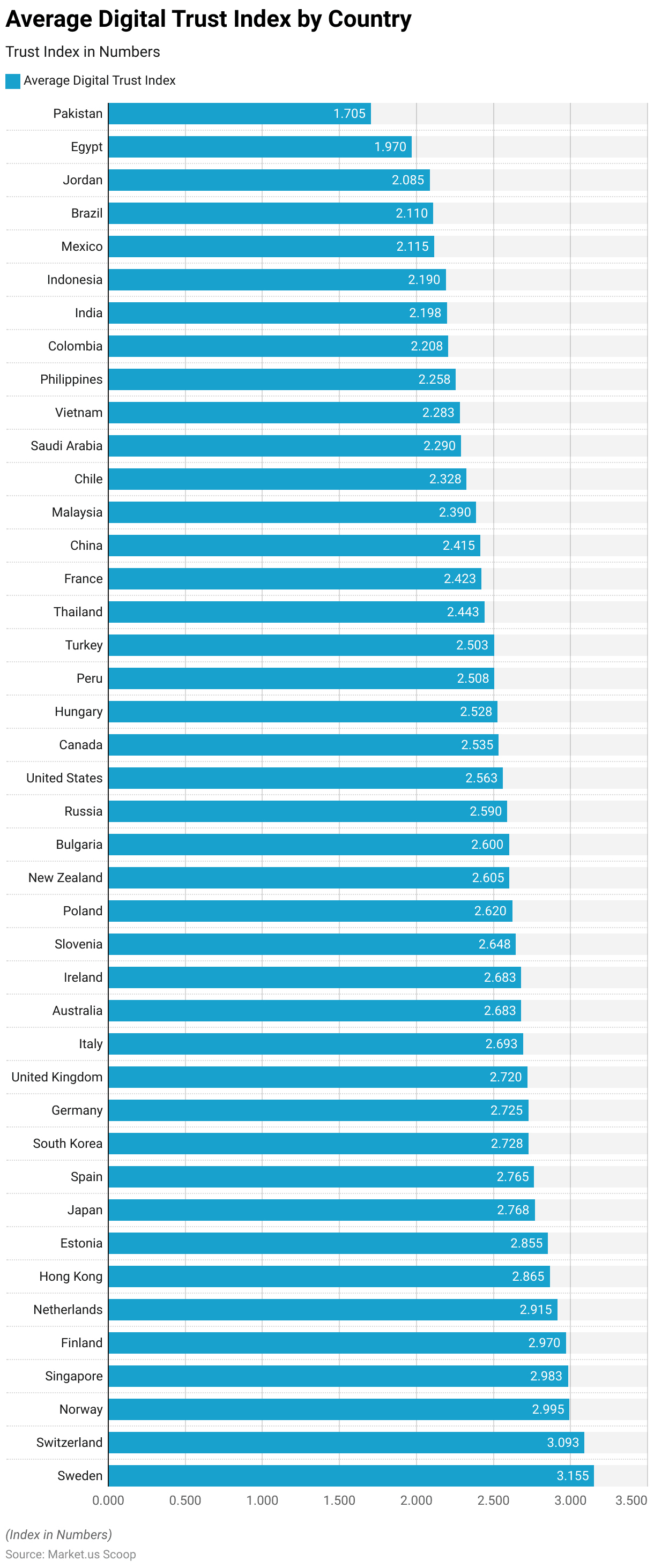Table of Contents
Introduction
According to Digital Trust Statistics, Digital trust is the bedrock of assurance concerning the security, privacy, and dependability of digital systems, services, and data, underpinning the triumph of online commerce, safeguarding information, technological progress, and cybersecurity. It plays a fundamental role in an era marked by data breaches and concerns about privacy and in the reception of emerging technologies such as AI and blockchain.
The fundamental elements of digital trust encompass aspects like security, privacy, openness, dependability, user experience, reputation, and adherence to legal and ethical principles, all of which are pivotal for nurturing trust in our swiftly evolving digital environment. Trust is indispensable for our internet interactions and transactions, exerting a critical influence on social, economic, and political consequences.
Editor’s Choice
- Phishing became the most prevalent cyber threat, bombarding inboxes with approximately 3.4 billion spam emails daily.
- The global average cost of dealing with data breaches reached a hefty $4.35 million in 2022, and breaches resulting from compromised or stolen login credentials carried an average price tag of $4.50 million.
- In 2022, ransomware attacks took a toll on 71% of businesses.
- Phishing emerged as the most prevalent, impacting a staggering 300,497 victims.
- The banking and financial sector emerged as the most trusted, with 42% of consumers expressing confidence in digital services within this industry.
- According to McKinsey’s analysis, banks have the potential to achieve cost savings ranging from 20% to 25% by transitioning to digital operations.
- Roughly 34% of Gen Z shoppers are highly skeptical towards most online stores.
- During the first half of 2022, the United States topped the list with a staggering 72,718 requests, showcasing the significant demand for user information.
Cybersecurity and Data Protection
Data Breaches
- In 2022, organizations worldwide faced a staggering 493.33 million ransomware attacks.
- Phishing became the most prevalent cyber threat, bombarding inboxes with approximately 3.4 billion spam emails daily.
- The global average cost of dealing with data breaches reached a hefty $4.35 million during that year, and breaches resulting from compromised or stolen login credentials carried an average price tag of $4.50 million.
- Unfortunately, the healthcare industry has held the unenviable title of experiencing the costliest breaches for a dozen years, with the average expense of a data breach in this sector spiking to $10.10 million in 2022.
Cybersecurity Statistics by Attack Type
- The FBI’s Internet Crime Report for 2022 reveals a comprehensive breakdown of cybercrime statistics by attack type, underscoring the diverse range of threats faced in the digital realm.
- Phishing emerged as the most prevalent, impacting a staggering 300,497 victims.
- Personal Data Breaches affected 58,859 individuals, while Non-Payment/Non-Delivery scams impacted 51,679.
- Extortion schemes preyed on 39,416 victims, while Tech Support scams affected 32,538.
- Investment fraud lured 30,529 victims, followed closely by Identity Theft at 27,922.
- Credit Card/Check Fraud impacted 22,985 individuals, and Business Email Compromise (BEC) schemes targeted 21,832 victims.
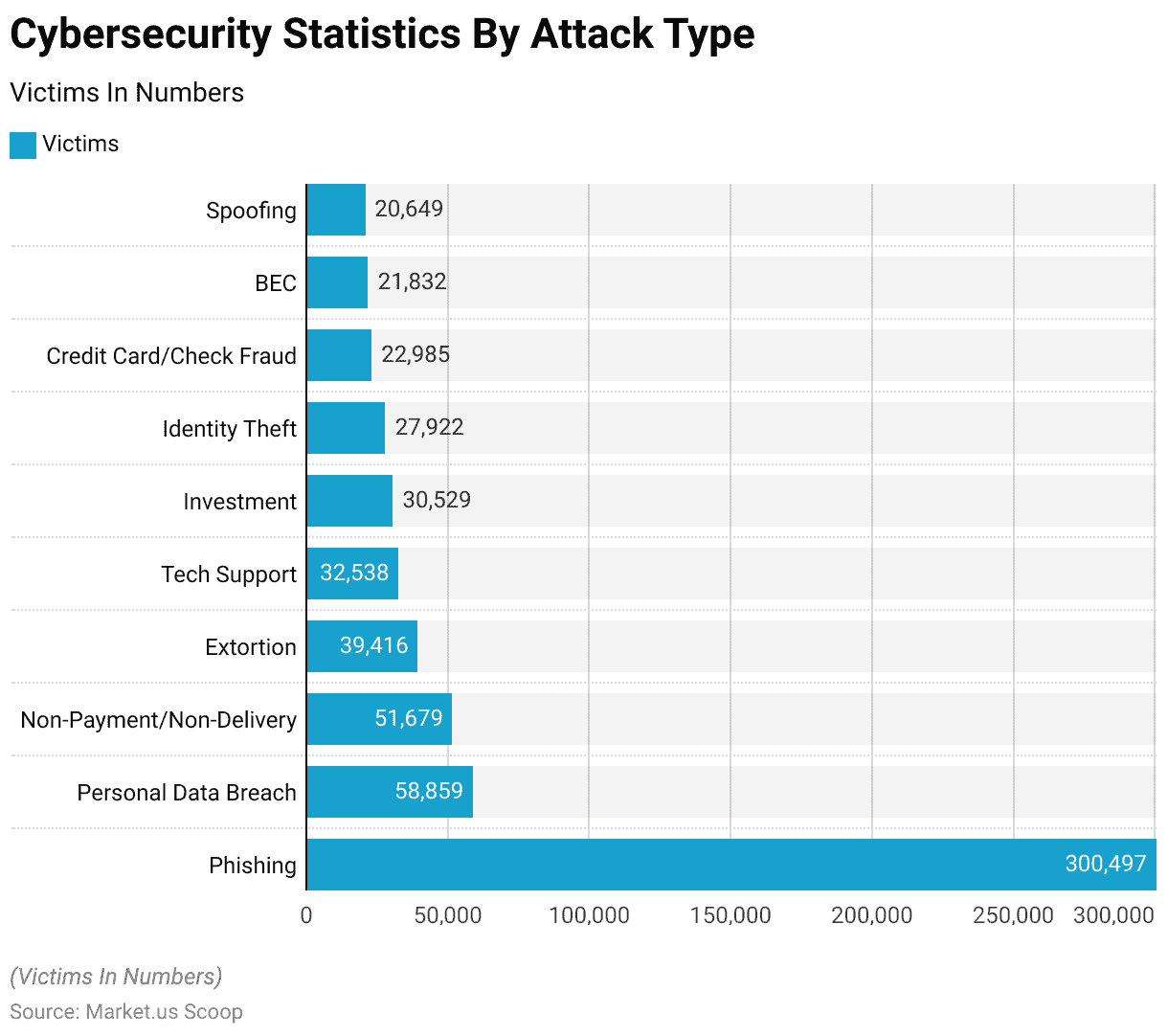
Privacy Concerns
- A recent report from PwC drives home a concerning reality for businesses: 85% of customers now hesitate to engage with a company if they have doubts about its data practices, highlighting the growing importance of proactive security measures.
- The survey findings mirror a broader trend where consumer trust in businesses appears to be eroding.
- Shockingly, only 12% of those surveyed stated that they trust companies more than they did a year ago, with a mere 17% indicating more trust than a decade ago.
- This leaves a substantial majority who gradually lose faith in the companies they deal with.
- Even more telling is that 88% of respondents link their willingness to share personal data directly to their trust in a company, and 87% are ready to take their business elsewhere if that trust is shaken.
Cybersecurity Incidents According to Industry
- As per a report from the US Homeland Security, a breakdown of cybersecurity incidents by sector reveals some interesting insights.
- The energy sector tops the list, accounting for 32% of these incidents, highlighting the critical need for security in this industry.
- Following closely, the critical manufacturing sector experienced 27% of these incidents, underscoring the vulnerabilities within manufacturing processes.
- The communications, water, healthcare, and government facilities sectors accounted for 6% of the incidents, indicating that no sector is immune to cybersecurity challenges.
Consumer Trust in Digital Services
- In 2022, global consumer trust in digital services showed a notable variation across different industries.
- The banking and financial sector emerged as the most trusted, with 42% of consumers expressing confidence in digital services within this industry.
- Healthcare providers followed closely, with 37% of consumers trusting digital healthcare services.
- However, consumer technology providers saw a slightly lower level of trust at 32%, indicating a moderate confidence level.
- In contrast, social media companies faced a significant challenge in gaining consumer trust, with only 18% expressing confidence in their digital services.
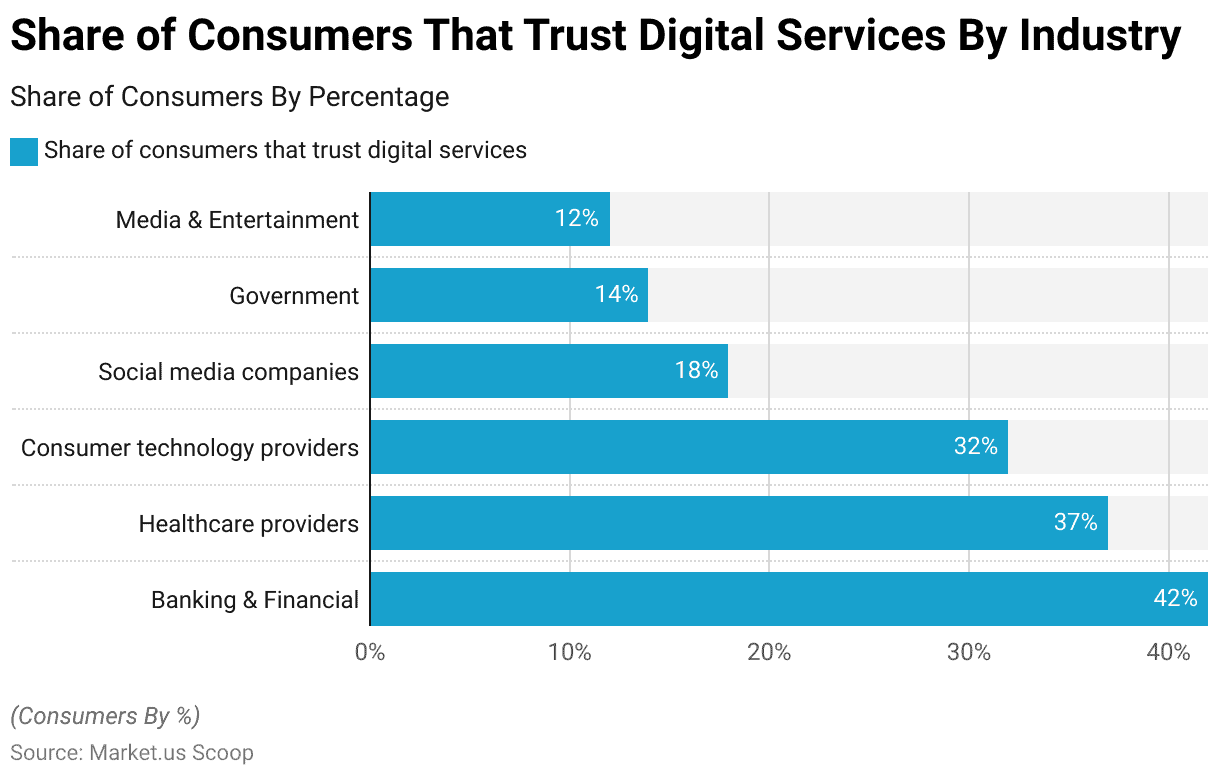
Online Banking Trust
- In a July 2020 survey conducted by Lightico with 1,329 Americans, it was observed that individuals with higher incomes tend to view financial transactions as a matter of significant sensitivity.
- Among banking customers, 55% indicated they would reduce their visits to the bank branch.
- An additional 26% intended to avoid in-person banking interactions.
- In contrast, 10% expressed their intent to increase their visits to the bank branch compared to their current frequency.
- Notably, banks have strong motives to encourage their customers to use more extensive digital services.
- According to McKinsey’s analysis, banks have the potential to achieve cost savings ranging from 20% to 25% by transitioning to digital operations.
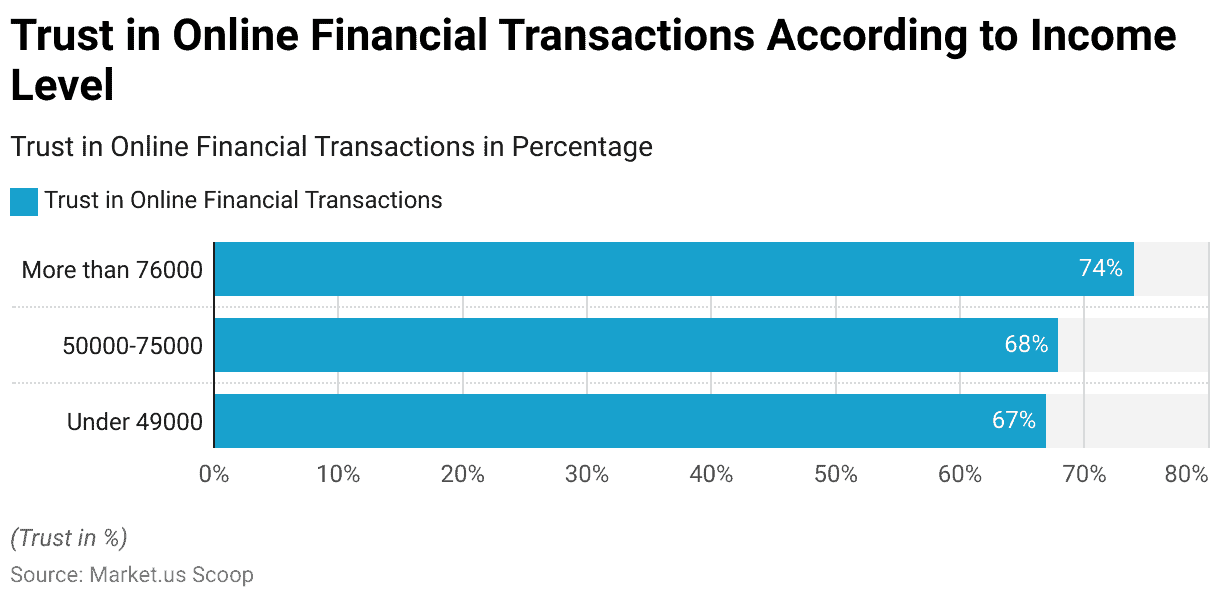
Social Media Trust
- A recent study conducted by UNICEF in collaboration with Gallup highlights that today’s individuals between the ages of 15 and 24 rely on social media and various online sources to stay informed about current events.
- However, it’s important to note that this reliance doesn’t necessarily translate into trust in the information they receive from these sources.
- In a survey encompassing 21 countries with varying income levels, young people in the 15-24 age group reported that they primarily use social media or online news sites to stay updated, with 45% indicating social media as their primary source and another 14% favoring online news sites.
- In contrast, older generations in these countries tend to turn to television, radio, and newspapers for their current affairs updates.
Trust in E-commerce Platforms
- Roughly 34% of Gen Z shoppers are highly skeptical towards most online stores.
- Notably, many website visitors fail to recognize trust seals, including some of the top 10 security seals known by less than 10% of shoppers.
- What’s been noted is that a combination of contemporary website design and quality seals associated with products is pivotal in bolstering a website’s credibility.
- When these elements are used together, they can increase the number of individuals who perceive websites as dependable by approximately 30%.
- Conversely, an excessive reliance on prominent promotional banners and popups has the opposite effect, effectively doubling the number of customers who view a website as untrustworthy.
- Furthermore, over 67% of customers abandon their shopping endeavors mid-way when suspicions are raised.
Trust in Online Reviews
- According to a survey conducted in October 2018, how people perceive and trust online reviews has evolved.
- In 2014, most didn’t always rely on reviews, with no “Yes, always” responses.
- However, by 2018, 19% of respondents claimed they always trusted online reviews.
- A notable shift occurred in the “Yes if I believe the reviews are authentic,” with 22% in 2014 and 31% in 2015, then a return to 19% by 2018.
- The attitude of “Yes, for some types of businesses, no for others” steadily declined from 34% in 2014 to 15% in 2018.
- “Yes, if there are multiple customer reviews to read,” experienced a minor increase from 26% in 2014 to 25% in 2018.
Digital Trust Issues Related to the Government
- During the first half of 2022, Google received numerous user data requests from federal agencies and governments across various countries.
- The United States topped the list with 72,718 requests, showcasing the significant demand for user information.
- India followed closely with 32,335 requests, reflecting the country’s growing digital presence and the government’s interest in data access.
- Germany and Brazil also demonstrated notable figures, with 25,668 and 11,515 requests, respectively.
- The United Kingdom, Poland, France, and Spain contributed to this trend with their respective figures of 9,853, 7,133, 6,125, and 4,912 requests.
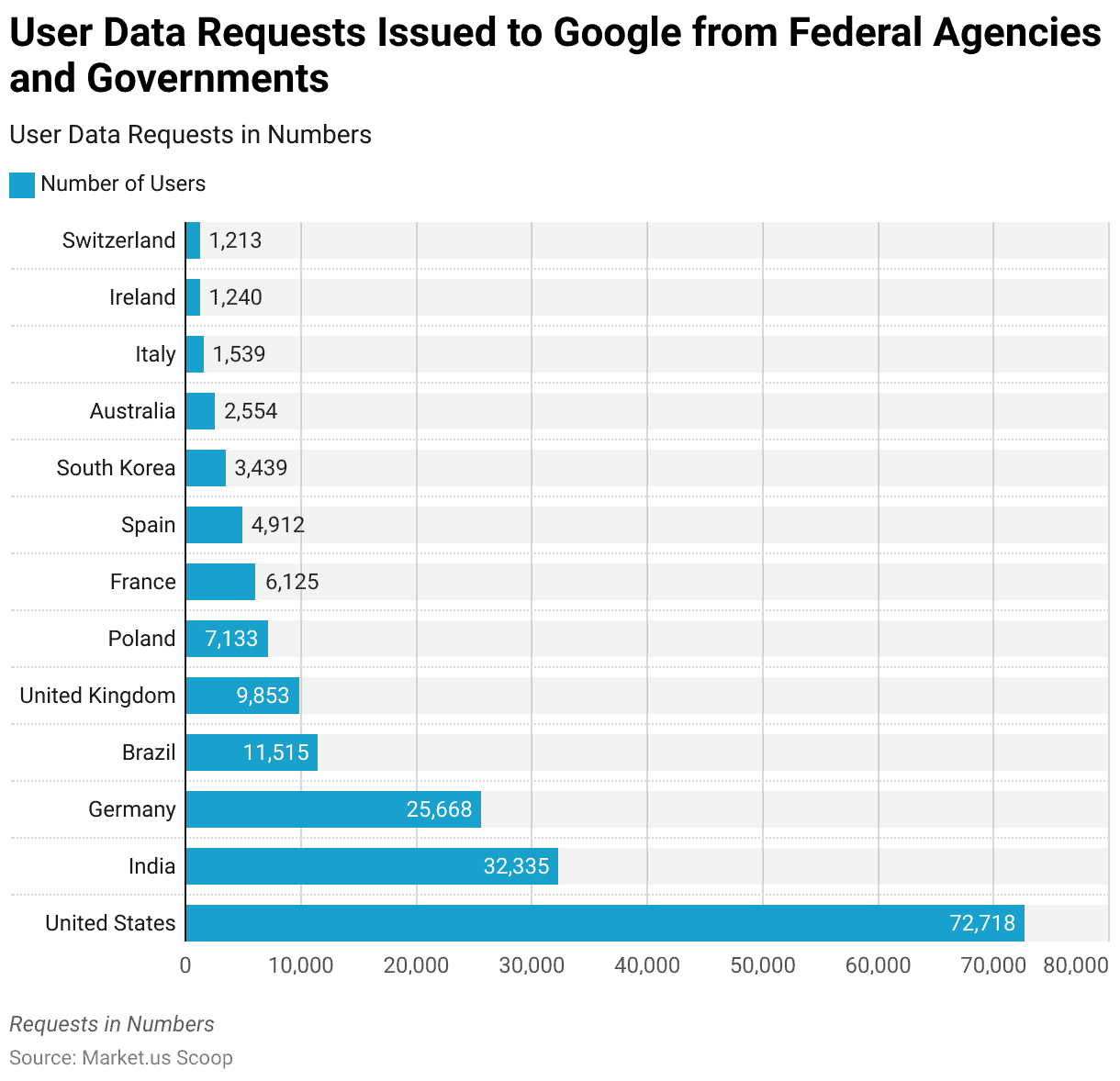
Digital Risks Mitigated by Organizations
- Organizations are actively addressing a spectrum of digital risks with various mitigation strategies.
- Cybersecurity remains a focal point, with efforts to mitigate these risks falling in the 33-41% range.
- Data privacy is another critical concern, and organizations are taking measures to manage these risks within the 23-31% range.
- Additionally, mitigating risks related to IT operations is a focus, with efforts spanning from 19-26%.
- Data quality concerns are managed with a commitment of 15-23%.
Digital Trust Index of Different Nations
- The Digital Trust Index, which measures trust in digital technologies and online platforms, was calculated for 42 countries.
- Topping the list with the highest average digital trust index is Sweden, with a score of 3.155, followed closely by Switzerland at 3.0925 and Norway at 2.995.
- These countries appear to have a high degree of confidence in digital systems.
- On the other end of the spectrum, Pakistan ranks at the bottom of the list with the lowest digital trust index of 1.705, while Egypt and Jordan also have relatively low trust levels at 1.97 and 2.085, respectively.
- The United States falls in the 22nd position with an average digital trust index of 2.5625, indicating moderate trust in digital technologies.
